Soriana
Organización Soriana is a Mexican public company and a major retailer in Mexico with more than 824 stores.[2] Soriana is a grocery and department store retail chain headquartered in Monterrey, Nuevo Leon, Mexico. The company is 100% capitalized in Mexico and has been publicly traded on the Mexican stock exchange (Bolsa Mexicana de Valores), since 1987 under the symbol: "Soriana".
 | |
| Type | Sociedad Anónima Bursátil de Capital Variable |
|---|---|
| BMV: SORIANA B | |
| Industry | Retail |
| Founded | 1968 |
| Headquarters | , Mexico |
Key people | Francisco Javier Martín, (Chairman) Ricardo Martin Bringas, (CEO) |
| Products | Consumer goods |
| Revenue | |
Number of employees | 93,700 |
| Website | www |
Overview

Soriana was founded in 1968 by Mexican entrepreneurs and brothers, Francisco and Armando Martín Borque, in Torreón, Coahuila. The company currently, as of 2013, operates under the brands Soriana, Clubes City Club, Hipermart, Mercado Soriana, and Super City. Super City is the company's convenience store division brand. It operates supermarkets and department stores for consumer and wholesale markets.

Soriana competes primarily with H-E-B, La Comer, Chedraui, S-Mart and Walmex. Soriana emphasizes that it is Mexican-owned and operated. It is not uncommon to see advertising circulars from competitors Wal-Mart, Bodega Aurrerá, Superama, Chedraui, Alsuper or H-E-B posted around the store with certain items highlighted, pointing out that these items are cheaper at Soriana, a common practice in retail store environments.
On December 6, 2007, Organizacion Soriana acquired Supermercados Gigante for US$1.35 billion. In 2008, Soriana replaced the existing Gigante stores including its seven stores in the United States (U.S. stores were sold in May to Chedraui). Most Mexican stores retained Supermercados Gigante props like point of sale systems and food equipment.
In 2012, it had more than 606 stores in 208 cities in Mexico under 5 store formats, which include 249 Soriana Híper, 105 Soriana Súper, 147 Mercado Soriana, 72 Soriana Express and 33 City Club. It also had 14 distribution centers. In 2006, for reporting and administrative purposes, Soriana moved its headquarters from Torreón to Monterrey.
History
The Beginnings of La Soriana
The Soriana company has its origins in 1905, the year in which Don Pascual Borque (from Soria, Spain) founded a fabric business and perfumery under the name 'LA SORIANA' in Torreón, Cohauila, later incorporating in 1920, a wholesale merchandise offer, which with this became a benchmark in terms of purchases and consumption in Torreón.[3][4][5]
In 1930, the brothers Armando and Francisco Martín Borque took over the management of the original business model, which began to expand in different municipalities of Coahuila, Durango, Chihuahua and Sonora. Years later, La Soriana changed its business model to retail.
The beginnings of Soriana as a supermarket
In 1968 La Soriana abandoned its fabrics and perfumery sector and changed its business model to supermarkets, opening its first hypermarket (commercial center at the time) in downtown of Torreón, Coahuila, marking the official start of Soriana with the aforementioned business model, currently known as Soriana Organization, and with it the beginning of its permanent territorial expansion.
In 1974, Soriana began its first geographical expansion, with the inauguration of its first hypermarket in the Metropolitan Area of Monterrey, Nuevo León, with the Soriana Vallarta store being the first branch in that city and therefore in the State of Nuevo León. Also in that same year, Soriana inaugurated its first hypermarkets in the States of Durango and Chihuahua with the branches of Durango Centro and Chihuahua Centro respectively, thus marking its first consolidation in any region of the country (in this case in the North of Mexico) and at its time turning Soriana into a regional supermarket chain.[6][7]
The 80s
In the 1980s, Soriana continued with its expansion and consolidation in the north of the country, opening its first store in the border city of Ciudad Juárez, Chihuahua in 1984, as well as opening another branch in the city of Torreón, Coahuila, as is Soriana Constitución.[8] Two years later, in 1986, Soriana arrived in another Mexican border city, Reynosa, Tamaulipas with its Soriana Hidalgo branch. Likewise, on September 30, 1987, Soriana began trading on the Mexican Stock Exchange under its ticker symbol SORIANA. At the end of the 1980s, the Martín Borque brothers had serious differences that led them to separate business, for which Don Francisco continued to lead Soriana with the company name "Tiendas de Descuento del Nazas" (Sorimex), and Don Armando traveled to the city of Monterrey, Nuevo León, Mexico to later create the Hipermart store chain, which had the name "Sultana Discount Stores" (Soriana Organization), which in 1989 created the Hipermart store, which established its first stores under that name in Monterrey (Cumbres and San Pedro), Ciudad Juárez (San Lorenzo) and Torreón (Independencia).
As part of Sorimex, in 1988 Soriana began to venture into western Mexico, with Aguascalientes being the first city in that Mexican region to open its first Soriana store, known as Aguascalientes Universidad. A year later Soriana opens its first store in Zacatecas (Soriana Zacatecas).
The 90s
In 1990, Soriana opened its first store in the Mexican Pacific in the State of Baja California (Soriana Tijuana Plaza Carrousel). However, due to an agreement with Casa Ley, said Tijuana branch was closed four years later, in which it was later replaced by Comercial Mexicana, which was ultimately acquired again by Soriana in 2015, which returned with its original name in 2017 with the conversion from Comercial Mexicana to Soriana Híper.
In 1994, the Martín Borque brothers joined forces again and merged both commercial chains (Soriana and Hipermart), leaving the company name as Soriana Shopping Centers, and as it is currently called Tiendas Soriana. In that same year, Soriana opened two stores in Jalisco, all of them in the Guadalajara Metropolitan Area (Soriana Bugambilias [which began operations under the pseudonym Hiperama until 2016 when it was renamed to its original management Soriana Híper], and Soriana Híper Río Nilo), as well as two stores in Guanajuato, in the cities of León (Soriana Malecón) and Irapuato (Soriana Jacarandas).
One year later, in 1995, Soriana continued its expansion plan with the opening of its first branch in the port of Tampico, Tamaulipas (Soriana Ejército). In 1997 Soriana began to venture into the center of the country in the State of Querétaro (Soriana Quintana), in which from 1998 onwards Soriana would reach more federal entities, such as San Luis Potosí in its Soriana El Paseo branch; Veracruz at its Soriana Coatzacoalcos El Palmar branch and Tlaxcala at its Soriana Tlaxcala branch. In December 1998 Mr. Francisco Martín Borque, founder and important promoter of the Soriana company, died.
In 1999, Soriana ventured into more regions of the country, reaching states such as Michoacán (Soriana Uruapan), Colima (Soriana Plaza Colima), Hidalgo (Soriana Plaza del Valle Pachuca), Puebla (Soriana Torrecillas), Tabasco (Soriana Villahermosa Guayabal, which ventures into the Mexican southeast for the first time) and Sinaloa (Soriana Culiacán Zapata), which the latter returns to the Mexican Pacific, this due to the breaking of the pact with Casa Ley of non-invasion of territories.
2000 - 2007
But in December 2000, Soriana, entering the State of Nayarit for the first time, opened its 100th branch in the city of Tepic (Soriana Cigarrera), becoming the fourth self-service chain to operate a hundred establishments under the same name. commercial, behind Cifra-Walmart, Tiendas Gigante and Comercial Mexicana.[9]
Subsequently, between 2001 and 2003, as part of its geographical expansion, Soriana ventured for the first time into the states of the Mexican southeast (Oaxaca in 2001; Yucatán and Chiapas in 2002 and Campeche and Quintana Roo in 2003) as well as in La Paz, Baja California Sur in 2002. In 2004, Fundación Soriana, A.C. was created as a company plan to strengthen and formalize corporate social responsibility programs.
On July 17, 2002, the price club, City Club, was created in Torreón, Coahuila, whose business model is responsible for serving families with high consumption as well as businesses through merchandise and products with wholesale sales volume and a half wholesale.[10][11] In that same year, Soriana launched its loyalty card, known as La Tarjeta del Aprecio (Tarjeta Recompensas since 2015 and Tarjeta Recompensas Payback since 2018) with the aim of rewarding customers for their purchases, which were awarded points on the loyalty card, either to accumulate points, obtain free or discounted products or exclusive products. One year later, in July 2003, the Mercado Soriana format was created, opening its first store of its kind in the municipality of Salamanca, Guanajuato, which consists of a medium-sized supermarket with a sales floor of between 3,500 and 5,000 m2. . with a low investment cost with competitive prices in all departments with a total of 25,000 products, in order to serve consumers located both in cities and towns of 50,000 to 150,000 inhabitants as well as in popular areas of large and medium-sized cities where It is not possible to locate a Soriana Híper.[12] From then on, Soriana began to include cities with fewer than 150,000 inhabitants and popular areas of large cities in its geographic expansion through the Mercado Soriana format, as well as expanding into new cities with its emblematic hypermarket and its price club City Club.
In 2005, in order to satisfy last-minute shopping needs as well as Soriana's goal of venturing into the convenience store business, the Super City format was created, whose objective is to compete against Oxxo and 7-Eleven at through operating under the franchise system as part of its expansion.[13] Likewise, in that same year Carrefour withdrew from Mexico, and consequently, although most of its stores in the center, west, south and southeast of the country were sold to Chedraui and the Monterrey branch was acquired by Walmart, Soriana acquired the Carrefour stores in the states of Coahuila (Saltillo Echeverría), Chihuahua (Chihuahua Saucito and Ciudad Juárez Alameda Iglesias) and Sonora (Hermosillo Bachoco), making this the second acquisition of supermarkets by the Soriana company.[14][15] Also, Soriana began to enter the metropolitan area of the Valley of Mexico for the first time with the opening of Mercado Soriana Ciudad Azteca, in the municipality of Ecatepec, State of Mexico, which with this opening marked the bases for its consolidation in the center of Mexico being the year 2005 the most important for Soriana.[16][17]
in April 2006, branch 200 of the commercial chain was opened, with the Ciudad Frontera branch (municipality belonging to the metropolitan area of Monclova, Coahuila), Also in that year, a new supermarket concept was inaugurated in Puerto Vallarta, Jalisco, this in turn with a provisional concept as a test that consists of a supermarket that offers consumers an agile and fast shopping experience through products from daily consumption. Likewise, and after 12 years of absence, Soriana returns to Baja California Norte with the Calafia and Otay branches, in the cities of Mexicali and Tijuana respectively, in addition to opening its first hypermarkets in the State of Mexico with the Ixtapaluca, Cofradías (in the metropolitan area of Mexico City) and Plaza Sendero Toluca (in the metropolitan area of Toluca),[18] this as part of its expansion plan in central Mexico. A year later, in 2007, Soriana opened its first store in Distrito Federal (today Mexico City) with the branch Mercado Soriana Ermita.[19]
Third supermarket acquisition: Supermercados Gigante; the creation of the Soriana Súper format; foray into new cities and transition of Soriana now as a national supermarket chain
December 6, 2007, is one of the most significant dates for the company, since Soriana, with an amount of 1,350 million dollars, acquired from Grupo Gigante the 199 Gigante stores that operated Mexican territory under its Gigante, Bodega Gigante formats, Súper Gigante, Súper G and Súper Maz, as well as 7 in the United States in its Gigante USA format (which were later sold to Chedraui, who converted them into their El Súper format). With this purchase and acquisition, Soriana consolidates its presence nationwide and also meant another opportunity for the company to formally compete in the Federal District market.
As of December 7, 2007 and until April 17, 2008, as part of the acquisition and merger of two companies, Gigante becomes a subsidiary of Soriana. At the beginning of 2008, due to said acquisition, the Soriana Súper format was officially created, which was created with the aim of offering quick purchases to the consumer and converting the Super G and Super Maz stores to this format, as well as some Gigante and Bodega Gigante branches, which had a sales floor of less than 3,500 square meters.
On April 18, 2008, the Gigante supermarket formats officially disappeared and all its stores, varying the size of the sales floor, were renamed to all the formats that Soriana handles (including the new Soriana Súper format). Likewise, Soriana began operations in the State of Morelos through the only former branch of Bodega Gigante in Cuernavaca, which was converted to Soriana Súper, which with said conversion and purchase of Tiendas Gigante, Soriana consolidates its presence in the 32 States of the Mexican Republic and, therefore, transcends to a national supermarket chain.[20]
2008-2014
After the purchase of 199 Gigante Stores and their conversion to the different company formats, as of April 18, 2008, Soriana became a national chain with its own hypermarket, supermarket, warehouse and price club formats, it began to compete and fight prices against other national chains, its main competitor being Walmart, which has a considerable presence in central Mexico.[21] Two years later, as part of its permanent geographic expansion and its multi-format strategy, in February 2010 the Soriana Express format was created in the municipality of Centla, Tabasco, whose format consists of a supermarket with a sales floor from 800 to 1,500 square meters, which is mainly aimed at localities and small cities that are around 10,000 to 50,000 inhabitants or in areas of high population density in large and medium-sized cities, in which Soriana began from there to include in its expansion plan small cities and/or communities of 10,000 to 50,000 inhabitants with the Soriana Express format.[22][23][24]
In September 2011, as part of its multi-format strategy, Soriana modified its organizational structure through the division of all its self-service formats for each market niche.[25] Likewise, Soriana launches its new premium supermarket concept, known as Soriana Super VIP, with the Soriana Super Marne branch in the municipality of San Pedro Garza García (Metropolitan Area of Monterrey), Nuevo León being the first store with this previously remodeled and renovated gourmet concept , which has a sales floor surface of 2,230 square meters (M2), responsible for marketing a wide variety of national and imported products such as wines and liquors, delicatessen and prepared foods; where you can find dishes from different countries prepared by chefs.[26][27]
In 2013, Soriana built its first wind power plant in the city of Reynosa, Tamaulipas, as part of the company's long-term Sustainability Plan. At the end of 2014, Soriana renewed its corporate image of both the organization and its different store formats, and with this the first store was opened with the change of image, in this case being the Soriana Súper San Agustín store, in the municipality of Tlajomulco de Zúñiga, Jalisco (belonging to the Guadalajara Metropolitan Area).
Purchase of the Comercial Mexicana Stores from Soriana
On January 28, 2015, and with a total amount of 39,194 mdp, Soriana acquired a large part of the 160 stores of Controladora Comercial Mexicana, along with the Comercial Mexicana, MEGA, Bodega Comercial Mexicana and Alprecio formats. , which would become subsidiaries of Soriana as of January 4, 2016.
In addition to purchasing Comercial Mexicana's supermarkets, Soriana also acquired other assets of high strategic value such as real estate assets corresponding to 118 stores, lease contracts with third parties corresponding to 42 stores, operating equipment and store inventory, also including the promotion of Julio Regalado, created in 1980 by Comercial Mexicana and which as of 2016 becomes part of Soriana..[28][29]However, and during the purchase and sale process, only 143 branches were purchased, this due to the conditions of the COFECE (Comisión Federal de Competencia Económica in Mexico) which detected that of the 160 branches for sale, if said transaction were completed, it would affect 27 markets, reducing competition and, as a consequence, an increase in prices for consumers, which Soriana, by order of the COFECE, would not buy the branches and, instead disincorporate various stores located in the markets at risk of significantly affecting competition.[30][31]
As a consequence of this condition, Comercial Mexicana kept 14 conditioned stores, while Soriana kept 13 to later be sold to third parties in the future, and with this the company was divided into two companies, that is, as of January 4 In 2016, the formats of Fresko, Sumesa, City Market and some units passed to Grupo LaComer, while the large formats such as Comercial Mexicana, MEGA, BODEGA and Alprecio, passed to the Soriana staff, which obtained the license to use of Comercial Mexicana brand for more than 2 years to later rename them to the formats managed by the company originally from Torreón, Coahuila.[32][33]
Store formats
Soriana Híper
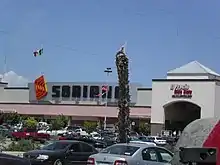
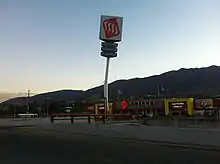
Soriana's flagship format created in 1968, whose store formats are hypermarkets that focus on consumers located in cities with more than 150,000 inhabitants, which have a sales floor area of 4,000 to 11,000 m2. They operate under the retail sales scheme, in which they handle a wide assortment of merchandise with 50,000 SKU's from the clothing, general merchandise, grocery and perishable food divisions. They have a shopping center made up of 40 or 50 small stores that the Company rents to third parties, who market products and services to the consumer.
Its main competitors are:
- Walmart Supercenter (Walmart) (Main competitor nationwide)
- Chedraui from Grupo Comercial Chedraui
- Casa Ley (Hypermarket)
- H-E-B (Partially)
- La Comer (Partially)
- Until January 3, 2016, it was competing against Comercial Mexicana, from Controladora Comercial Mexicana.
In 2008, most of the Gigante Stores were converted to Soriana Híper, as well as some Bodega Gigante, three Super Gigantes in Baja California Norte and one Super Maz store in Mérida.
In 2017, Soriana converted 14 Comercial Mexicana stores from Baja California Norte into Soriana Híper and in 2018, Soriana converted part of the 47 formats of Tienda Comercial Mexicana to Soriana Híper, mainly in northern areas of Mexico, as well as in the cities of Mazatlán, Culiacán, Hermosillo, La Paz, Veracruz, Mérida, Zamora and Celaya.
Likewise, Soriana Híper has two sub-formats, such as Soriana Híper Plus and MEGA Soriana, the latter derived from the purchase of Comercial Mexicana in 2016:
Soriana Híper Plus
It is a subformat of the Soriana Híper stores in which it is located in mature markets with areas with high purchasing power customers. This format was designed to provide, in addition to what Soriana Híper offers, high value products such as wines or gourmet foods, in which its merchandise level extends to 60,000 SKU's in addition to its stores being redesigned.
Its main competitors are:
- HEB (mostly)
- La Comer from Grupo La Comer (mostly)
- Walmart Supercenter (partially)
- Selecto Chedraui (main competitor at the national level)
- Until January 3, 2016, it was partially competing against Comercial Mexicana in its Mega Comercial Mexicana format.
The following Soriana Híper stores are considered as Soriana Híper Plus:
- Gran Terraza Coapa (Mexico City)
- Plaza Miyana Polanco (Mexico City)
- Pilares (Mexico City)
- Viñedos (Torreón)
- Hipermart Independencia (Torreón)
- San Pedro (Monterrey)
- San Nicolás (Monterrey)
- Galerías Valle Oriente (Monterrey)
- San Jerónimo (Monterrey)
- Aviación (Guadalajara)
MEGA Soriana
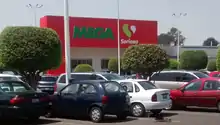
This format was created by Soriana in 2017, derived from the purchase and sale of Comercial Mexicana. In that moment Soriana analyzed the proposal of the Mega Comercial Mexicana format, and once the license to operate the Comercial Mexicana formats was expired, Soriana would retain the name Mega, due to the acquisition of 70 properties assigned with the name. Of all the formats, Mega was the only one that Soriana kept from the previous owners.
This store format is also a subformat of Soriana Híper and it's aimed at cities with more than 150,000 inhabitants, in which they handle a wide assortment of merchandise with 60,000 SKU's, in addition to what the Soriana Híper stores offer, products such as gourmet foods and wines, as well as services in which its predecessor MEGA Comercial Mexicana operated before its transition to MEGA Soriana, such as Grand Café, Bocatto and Fábrica de Quesos. Its interior designs are similar to the recent and latest designs of the Comercial Mexicana stores before its reinvention as La Comer; including its coffee shop and pastry brands. Its average sales floor area ranges from 4,500 to 14,000 square meters.
This move was confirmed with the conversion of Soriana Híper División del Norte in Mexico City, which now remains as Mega Soriana as of March 2017. In 2018, most of the stores in the center, south and southeast zones of Mexico that previously had the Comercial Mexicana and Mega Comercial Mexicana formats were converted into Mega Soriana, as well as some Bodega Comercial Mexicana units in the states of Mexico, Guerrero, Hidalgo, San Luis Potosí and Morelos.
As a mega market, its main competitors are:
- HEB
- La Comer
- Walmart Supercenter
- Chedraui and Selecto Chedraui
Soriana Súper
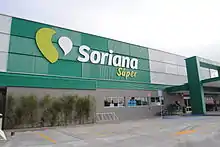
Format created in 2008, derived from the purchase of Tiendas Gigante by the company, based on the original Super G stores. They are stores that handle daily consumption products such as Groceries, Perishables and Prepared Foods, in which made with the objective of proportional to the consumer agile and fast purchases, under a sales floor area of 500 to 4,000 m2 and are located mainly in three areas: areas with middle and high income population (residential subdivisions), in areas whose areas and / or dimensions it is not possible to locate a Soriana Híper store and cities where there were many Gigante stores, which, varying in size, were converted to Soriana Super.
As a generalist supermarket, its competing stores are:
- Calimax
- Sumesa (La Comer Group)
- Walmart Express;
- Super Ley and Super Ley Express
- Super Chedraui
- Aka Superbodega, by Grupo Arteli
In 2008, all the Super Gs were converted into Soriana Súper (except one branch in Tijuana and two in Ensenada, which changed to Soriana Híper); most of the Super MAZ stores; and some stores Gigante and Bodegas Gigante, whose sales areas were less than 4,000m2.
In 2015, Soriana acquired and transformed the four Super Frutería del Sol stores in the Sonoran border city of San Luis Río Colorado to Soriana Super.
In 2018, Soriana converted two Comercial Mexicana stores in Acapulco and Cancún into Soriana Super, since both had a surface area of less than 3,000 m2. each.
Likewise, Soriana Súper has two sub-formats, such as Soriana Súper Plus and Soriana Supermarket, in which both sub-formats are "fresh market":
Soriana Súper Plus
It is the premium sub-format of Soriana Súper created in 2011 where, in addition to what Soriana Súper offers, grocery products and imported foods such as exotic meats are handled. Its first branch was installed on the foundations where Soriana Super Marne was located, a store that was previously part of Gigante.
As a premium supermarket format, its main partial competitors are chain stores such as:
- Aladdin's
- Select Super Chedraui
- City Market of Grupo La Comer
Soriana Supermarket
It is the fresh market sub-format of Soriana Super created in 2020 in which they handle grocery products, perishable goods and prepared food, as well as wines and gourmet foods. As a fresh market supermarket format, its main competitors are:
- Super Ley Express Fresh from Casa Ley (mainly, by location of the first branch)
- Super Chedraui
- Fresko from Grupo La Comer (main competitor at the national level)
- Until October 2020, it was competing with Superama. As of November 2020, Soriana Súper is a direct competitor of Walmex's now renamed Walmart Express.
The following Soriana Súper stores are considered as Soriana Súper Plus and Soriana Supermarket:
- Marne (Monterrey)
- Pueblo Serena (Monterrey)
- Valle (Monterrey)
- Plaza Nativa (Monterrey)
- Valle Poniente (Monterrey)
- Plaza Universidad (Guadalajara)
- Plaza Terranova (Guadalajara)
- Pablo Neruda (Guadalajara)
- Cititower (Guadalajara)
- Urbania (Guadalajara)
- Eugenia (Mexico City)
- Santa Fe Paradox (Mexico City)
- Toriello (Mexico City)
- Town Square Metepec (Toluca)
- Kukulkan Plaza (Cancún)
- Misión San José (San José del Cabo, BCS)
- Gavilanes (Zacatecas)
- Sendera Colima (Colima)
- Costa Azul (Acapulco)
- Alameda Iglesias (Ciudad Juárez, Chihuahua)
Soriana Mercado
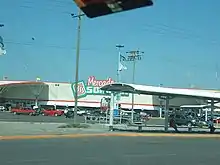
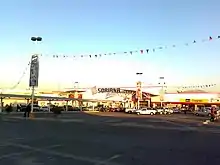
Format created in 2003, in which they are self-service warehouses with an average sales floor area of 4,000 to 5,000 m2., Focused mainly on cities with 50,000 to 150,000 inhabitants and in popular areas in large and medium cities where it is not possible to locate a Soriana Híper store. They handle the fastest-moving products in the hypermarkets of the grocery, perishables, prepared food divisions, and a selection of clothing and general merchandise products. They are shops with modest decoration, with a good level of comfort. In some cities, Soriana Mercado changes to Soriana Híper if there is more demand than the store covers; so the transition is noticeable in the design. In the event that the store's demand is less than what it covers, in that case, change to the Soriana Express subformat.
As a self-service warehouse type, its main competitors are:
- Bodega Aurrerá
- Chedraui and Super Che
- Casa Ley
- Until January 3, 2016, it was competing against Comercial Mexicana in its Bodega Comercial Mexicana format.
In 2008, Soriana converted most of the Bodega Gigante and some Gigante stores into Soriana Mercado. In 2018, Soriana converted a large part of the 32 formats of Bodega Comercial Mexicana to Soriana Mercado, and in the case of the center of the country, firstly Soriana kept the Bodega brand temporarily, and later, in 2019, change to Soriana Mercado permanently. Likewise, in 2018, Soriana converted the Comercial Mexicana Texcoco Aeropuerto store into Soriana Mercado, because the store has a surface area of less than 4,900 m2, whose surface was counterproductive to be converted into MEGA Soriana.
Soriana Express
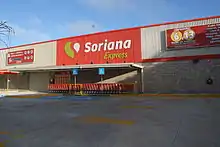
Subformat of Mercado Soriana created in 2010 based on areas, cities or towns where neither Soriana Híper nor Mercado Soriana can be located; suitable for cities of 10,000 to 90,000 inhabitants. They are stores with an average sales area of 1,500 square meters and are located mainly in areas with a low and middle-income population, in which they offer everything necessary to satisfy consumer needs in populations where they are present, such as groceries, clothing, etc. prepared foods, perishable and general merchandise in a moderate but complete way.
As a rural supermarket, they compete mainly with:
- My Bodega Aurrerá
- Ley Express and Super Ley Express
- Super Kompras Micro
- Super Che
- Some independent local stores in each town where Soriana is present.
- Until January 3, 2016, it competed with Alprecio, from Comercial Mexicana.
In the 2010s, Soriana converted some Gigante, Bodega Gigante and Super Maz stores into Soriana Express where these requirements were met. In 2019, after temporarily using the Bodega Soriana brand, Soriana converted the three Alprecio stores into Soriana Express.
City Club

Format created in 2002, which consists of stores in the form of a warehouse club with an area of between 7,000 and 11,000 square meters of sales floor, to which there is income only by paying a membership and are focused on high-volume families of consumption and institutional clients (hospitals, hotels, restaurants and small businesses).
They operate under the wholesale and half wholesale scheme, present the products in large containers and / or multiple packages, operate with large purchase volumes and low marketing margins. They handle 5,000 SKUs from the grocery, perishables, clothing and general merchandise divisions.
Its direct competitors are:
- Sam's Club (mainly nationally)
- Costco Wholesale (primarily nationwide)
- Ley Mayoreo and Super Mayoreo Ley (competitor to some extent, due to its wholesale sales scheme)
- Centrals or Supply Markets of the cities where it is present.
In 2008, Soriana converted two Gigante stores in Mexico City, two Gigante stores in Monterrey and one Gigante store Querétaro as well a Bodega Gigante store in Puebla into City Club, this because they were Gigante stores where there were already Soriana in the vicinity of them (mainly) or where, having at least two or more Gigante branches and one of the two buildings would have already been converted.
Super City

Format created in 2005 under the format of convenience stores which have a sales surface area between 70 and 80 m2 and currently no longer operate under the franchise system. They handle last minute shopping products such as coffee, snacks, sweets, bakery, groceries and beverages, among others.
Its main competitors are:
- Oxxo (FEMSA)
- 7- Eleven (Chapa House)
- Extra (Model Group)
- Circle K
- Super Kiosko (Only in Sinaloa, Nayarit, Jalisco, Colima and Michoacán)
- Bodega Aurrerá Express (competing to some extent, because it is an express supermarket)
- Chedraui Supercito (competitor to some extent, because it is an express supermarket)
- Farmacias Guadalajara (competing to some extent, since it is a super pharmacy)
Sodimac Homecenter
In 2016, Soriana entered into a collaboration agreement with the Chilean retail company Falabella for the opening of stores of the Sodimac chain in Mexican territory. The deal gives Soriana and Falabella 50-50 equal control of Sodimac's Mexican subsidiary. Its first store opened on August 3, 2018, in the municipality of Cuautitlán Izcalli, State of Mexico in the metropolitan area of the Valley of Mexico, next to a Mega Soriana supermarket. Other openings have occurred in the municipalities of Tlalnepantla and Naucalpan in the same state, in the municipality of Cuernavaca in the state of Morelos, as well as in the states of Veracruz and San Luis Potosí.
These stores are formats dedicated to the sale of construction material (Sodimac Constructor), hardware, home improvement and DIY, as well as services related to these activities, and installed in properties where Soriana already had another of its formats (especially those of the Mega Soriana and Soriana Híper formats).
Its main competitor at the national level is the North American The Home Depot, as well as local hardware stores such as Ferreterías Fix and Comex. Due to the type of turnaround of its departments, it also competes indirectly against The Home Store from Grupo Gigante, Zara Home of Grupo Inditex and Bed Bath & Beyond. Before leaving the Mexican market, it also competed against the North American Lowe's.
Promotions in Soriana
Soriana promotes its "Tarjeta del Aprecio" (appreciation card), whereby customers who purchase items earn points for free merchandise, and in-store credits for 20% off in general merchandise.
Sponsor
Soriana is currently the shirt sponsor for the Primera División de la Federación Mexicana de Fútbol (Mexico's Top League) football club Santos Laguna.
Slogans and trade names
- Donde Todos los Días son Buenos Días, Where all Days are Good Days (late 1970s)
- Responde cuando usted lo necesita, Responds when you need it (1988)
- Todos los Caminos Conducen a Soriana, All Ways Lead to Soriana (1990)
- Lo Mejor al Mejor Precio, The Best at the Best Prices (1993)
- En Suma Pagas Menos, pun meaning Pay Less for the Total or In Short, Pay Less (mid 1990s)
- Nuestros Precios Hablan, Our Prices Speak (1999, 2011)
- Apre¢io Por Ti or A pre¢io Por Ti, a pun meaning both (At the Right) Pri¢e for You or E$teem for You (2000)
- Mejores Ofertas a Precios Más Bajos, Better Offers at Lower Prices (2001)
- El Precio Más Bajo Garantizado, The Lowest Price Guaranteed (2002)
- El Mayor Ahorro, The Greatest Savings (2007)
- Porque nos importas tú, Because We Care for You (2008)
- ¡Hazlo hiper, y ahorra!, Do hyper, and save! (2013)
Evolution
Store openings by state:
- 1968 Coahuila
- 1971 Durango
- 1972 Chihuahua
- 1974 Nuevo León
- 1984 Tamaulipas
- 1989 Zacatecas
- 1990 Aguascalientes
- 1994 Jalisco, Guanajuato
- 1997 Querétaro
- 1998 San Luis Potosí, Veracruz, Tlaxcala
- 1999 Michoacán, Colima, Sinaloa, Sonora, Tabasco, Hidalgo, Puebla
- 2000 Nayarit
- 2001 Oaxaca
- 2002 Yucatán, Chiapas, Baja California Sur
- 2003 Campeche, Quintana Roo
- 2005 State of México
- 2006 Baja California
- 2007 Distrito Federal (today Mexico City), Guerrero
- 2008 Morelos
Criticisms and controversies
Mexico's 2012 Presidential Elections Soriana gift cards vote buy
At a news conference, the leftist candidate Andrés Manuel López Obrador claimed that the election was "plagued with irregularities" and accused the Institutional Revolutionary Party (PRI) of allegedly buying votes in favor of Enrique Peña Nieto.[34] He also claims that the PRI handed out gifts to lure voters to cast their vote in favor of them.[35] During the day of the 2012 presidential elections, people who voted for el PRI would receive pre-paid gift cards. Nonetheless, the PRI and the store denied such accusation[36] and threatened to sue López Obrador.[35] Peña Nieto vowed to imprison anyone – including members of the PRI – if they are found guilty of electoral fraud.[37] Despite Enrique's statement many videos by citizens about the Soriana cards surfaced on YouTube.[38][39]
See also
References
- "SORIANAB: Organizacion Soriana SAB de CV Stock Price Quote - BMV Mexico - Bloomberg". Archived from the original on 2012-10-12.
- Farfan, Barbara. "The Largest Mexican Retailers Gain on Global Competitors Like Walmart". The Balance Small Business.
- "La Soriana y su evolución". retailers.mx. Retrieved 2019-01-11.
- "Primer "Soriana" fue una tienda de telas: ¿Cuál es la historia y quién es el dueño del supermercado?". www.radioformula.com.mx. Retrieved 2019-01-11.
- "¿Qué significa la palabra Soriana y cuál es el origen de este supermercado?". www.radioformula.com.mx. Retrieved 2019-01-11.
- "Historia de Soriana, el supermercado mexicano que nació en Coahuila". www.telediario.mx. Retrieved 2023-06-13.
- "Soriana nació como una tienda de telas en una pequeña esquina de Torreón". www.elsoldelalaguna.com.mx. Retrieved 2022-11-11.
- "Telas Soriana, el origen de la famosa tienda comercial". www.america-retail.com. Retrieved 2022-06-17.
- "Nuestra Historia / Corporativo Soriana". www.organizacionsoriana.com. Retrieved 2023-07-03.
- "City Club cumple 20 años al servicio de sus 1.4 millones de socios". Revista Contacto. Retrieved 2022-07-25.
- "City Club de Soriana cumple 20 años". Retailers. Retrieved 2022-07-25.
- "Llega Mercado Soriana". Retailers. Retrieved 2011-09-20.
- "Super City busca competir con Oxxo". Expansión. Retrieved 2008-01-25.
- "Vende Carrefour sus activos a la cadena Chedraui". Jornada. Retrieved 2005-03-11.
- "La compra de Carrefour". Expansión. Retrieved 2011-09-14.
- "La Mega Soriana, un Gigante de la Laguna". El Sol de México. Retrieved 2008-01-25.
- "Soriana incursiona en el DF". El Siglo de Torreón. Retrieved 2008-01-25.
- "Abre sus puertas Plaza Sendero Toluca". Vlex. Retrieved 2006-10-03.
- "Historia de Soriana". Historia de Grandes Exitos. Retrieved 2012-03-21.
- "Soriana compra las tiendas de Gigante". Expansión. Retrieved 2007-12-06.
- "Soriana da la batalla a Walmart". Expansión. Retrieved 2008-06-17.
- "Soriana registró ganancias de 261%". El Economista. Retrieved 2010-02-23.
- "Soriana, 10 años de su formato Express". El Economista. Retrieved 2020-02-07.
- "Soriana crea táctica para captar clientes". El Universal. Retrieved 2010-06-07.
- "Soriana se reorganiza para vender más". Expansión. Retrieved 2011-09-19.
- "Soriana va por consumidores pudientes". Expansión. Retrieved 2011-09-09.
- "Soriana anuncia la reapertura de su tienda Soriana Súper Marne". retailers.mx. Retrieved 2011-09-14.
- "Soriana compra a la Comercial Mexicana por más de 39 mil millones de pesos". Aristegui Noticias. Retrieved 2015-01-29.
- "Soriana compra 160 tiendas de La Comer por 39,194 mdp". El Financiero. Retrieved 2015-01-29.
- "Cofece frena a Soriana para venta de tiendas de Comercial Mexicana". El Universal. Retrieved 2018-10-10.
- "SORIANA ya tiene a 'JulioRegalado'". Conexión 360. Retrieved 2016-06-09.
- "Aprueban a La Comer inicio de Escisión". Entre Veredas. Retrieved 2015-07-03.
- "Al pelícano de La Cómer le quedan dos años de vida con Soriana". Forbes. Retrieved 2015-11-05.
- "Pena Nieto set to become Mexico's president". Al Jazeera. 3 July 2012. Retrieved 18 July 2012.
- Diaz, Lizbeth (9 July 2012). "Mexican leftist refuses to accept election result". Reuters. Retrieved 18 July 2012.
- "Mexican retailer lashes out at losing presidential candidate". 2 August 2012.
- Oppenheimer, Andres (15 July 2012). "Mexico's president-elect vows to imprison vote buyers". Miami Herald. Retrieved 19 July 2012.
- Tuckman, Jo (4 July 2012). "Mexico elections: claims of dirty tricks cast shadow over Peña Nieto's victory" – via www.theguardian.com.
- "Throngs in Mexico hit stores with gift cards they say came from election-winning PRI". nydailynews.com. Associated Press.